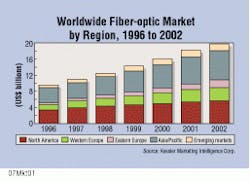atm switching systems invade public networks
atm switching systems invade public networks
Asynchronous Transfer Mode (atm) technology is strongly entrenched in public carrier networks for data communications, according to Dittberner Associates Inc., a Bethesda, MD-based telecommunications management consulting firm. Dittberner published its findings in "atm Switching Systems in Public Networks," Volume Two of its Advanced Technology Study Series, titled Project ess.
Donald Dittberner, company president, says, "Installation of atm switches into public networks around the world is occurring at a rate that far exceeds the historical rate of installation achieved in the early phase of digital central office equipment. But more than 80% of the installed atm switches are used today to provide backbone facilities for X.25 or frame-relay services in either public data networks or carrier-outsourced private networks."
The study finds that the overwhelming majority of the world`s installed base of public network atm switches are manufactured by nontraditional central office equipment suppliers. Cisco/Stratacom heads the list, with 32% of the total installed atm switching systems in public carrier networks. In second place, with 18% of the installed base, is Nortel, which is the only traditional central office manufacturer in the top five. Rounding out the top six suppliers are Newbridge at 19%, Fore Systems and General Datacom at 7% each, and Lucent Technologies at 5%. These six companies have captured 88% market share.
The study also reveals that atm installations have been recently spurred by installations by Internet service providers. In 1996, Internet backbone operators constituted 8% of all installed ports. However, by the year 2004, this percentage is expected to more than double to 17%.
The number of systems and equivalent DS-3 (45-Mbit/sec) and OC-3 (155-Mbit/sec) ports presently installed in public networks demonstrates the market strength of atm installations. The study declares that 12,426 atm systems, with an estimated 214,591 ports, presently comprise the public-network operator-owned installed base. More than 2980 atm systems are predicted to be on order for delivery during the next six months. At this pace, the total installed base of atm systems in public networks could more than double by year-end. This growth is taking place despite the fact that most public telecommunications operators are showing little interest in applying atm switching technology in established public switched telephone networks.
"Digital Switching Systems," Volume One of the report, was released last January; it covers the installed base of digital central office switching systems. For more information on both volumes, call (301) 652-8350.
Worldwide fiber-optics market to grow 13% annually to 2002
The worldwide fiber-optics market is expected to increase at a compound annual growth rate of 13%, rising from $9.7 billion in 1996 to $19.8 billion in 2002. This market covers the three major components of fiber-optic networks: cabled fiber, transmitter-receiver pairs or transceivers, and connectors.
Kessler Marketing Intelligence Corp., a fiber-optics market research company based in Newport, RI, reported these market projections in 1997 FiberGlobe Annual Report on Worldwide Fiberoptics Markets. This database provides component information on unit volumes, prices, and sales levels in 54 markets for singlemode and multimode fiber applications.
The report finds that the Asia-Pacific area has replaced North America as the largest regional market and is expected to maintain that leadership role for several years. Western Europe is anticipated to remain the world`s third-largest fiber-optics market, with Eastern Europe the fastest-growing segment. Emerging markets include the Middle East, Africa, Latin America, and the Caribbean.
Applications for singlemode fiber include long-haul telecommunications, feeder/local telecommunications, cable TV, and other private networks, such as for power utility, mobile communications, video, medical, and military uses.
Singlemode fiber markets achieved 82% of the $9.7 billion market in 1996; multimode fiber, 18%. By the year 2002, the singlemode fiber market is predicted to rise to $15.4 billion, or 78% of the worldwide market; multimode fiber, 22%. During this period, singlemode fiber sales are estimated to increase 12% annually; multimode fiber sales, 16% annually.
The cabled fiber market sector is forecast to more than double, from $6.6 billion in 1996 to $13.6 billion in 2002. Average link lengths are figured to decrease due to the saturation of the long-haul network market and to the rapid growth of local telecommunications networks throughout most of the world. Between 1996 and 2002, worldwide transceiver and connector unit volumes are projected to skyrocket by 223% and 251%, respectively.
During the reporting period, the feeder/local telecommunications market segment will experience the largest growth. In 1996, this application sector represented 25% of all singlemode fiber applications; long-haul telecommunications, 37%; cable TV, 12%; and other private networks, 8%. By 2002, however, the feeder/local telecommunications sector is expected to surge to a 42% market share. The long-haul telecommunications, cable-TV, and other private network sectors are expected to drop to 21%, 8%, and 7%, respectively. Nevertheless, during the six-year reporting period, the cable-TV sector is assessed to increase 6% annually; the other private network sector, 11% annually.
Accruing an 18% market share in 1996, multimode fiber applications are analyzed to climb to 22% in 2002, thereby achieving the second-largest market segment share. Call (401) 849-6771 for more information.
Telecommunications product sales escalate 15%
The total U.S. factory sales of electronic equipment, components, and related products reached $409 billion in 1996, a 9% increase over 1995 statistics, according to figures released by the Electronic Industries Association (eia) in Arlington, VA. Of the total market, the telecommunications product sector demonstrated the largest yearly increase of 15%, with sales of $63.5 billion in 1996 compared to $54.9 billion in 1995.
According to eia president Peter F. McCloskey, "Electronic sales continue to outperform the economy as a whole. Our forecasts for 1997 indicate another record-breaking year on the horizon."
